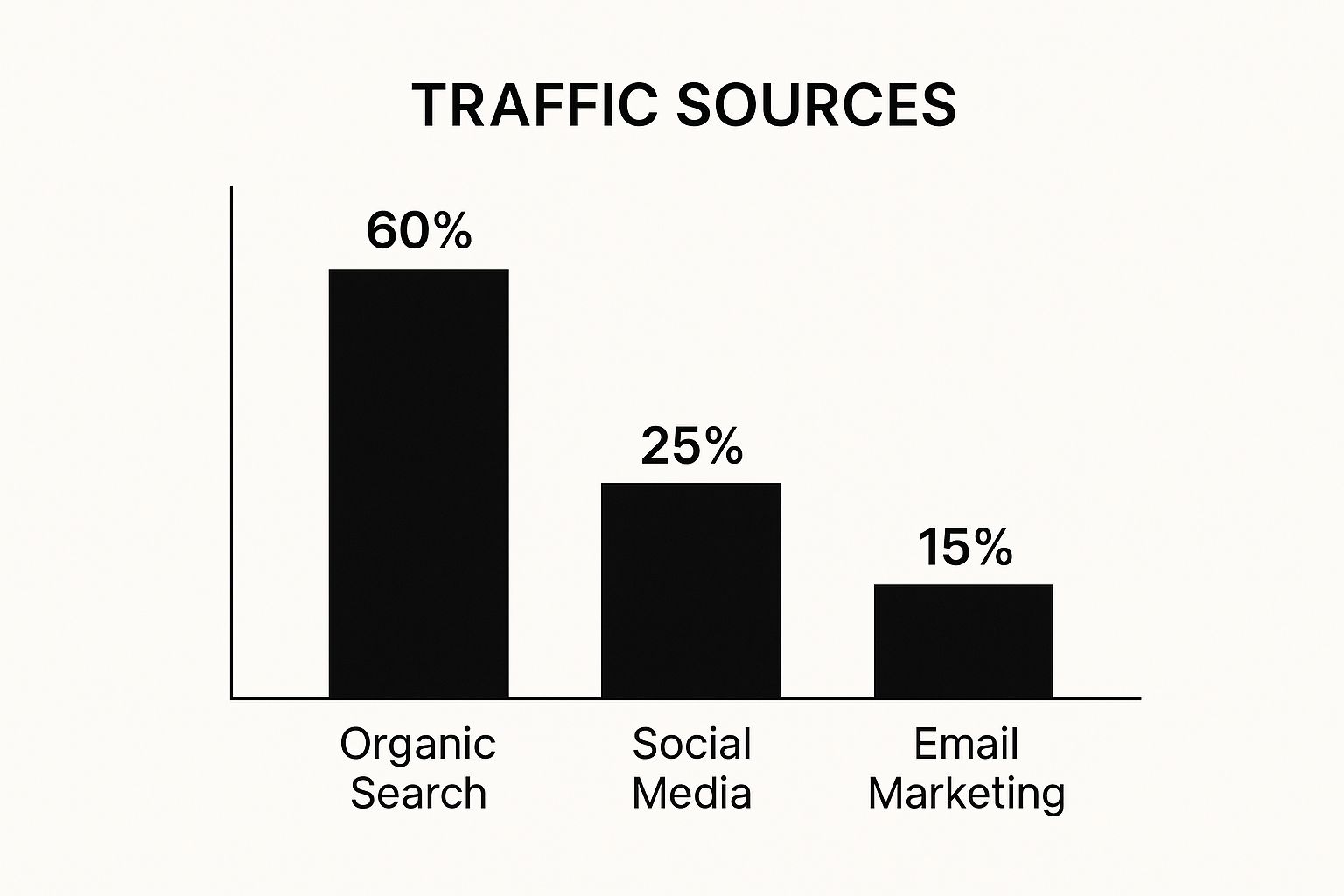Setting up a successful affiliate marketing program is about more than just finding people to sell your stuff. It's about building a genuine, performance-based partnership channel. At its heart, you're creating a system that’s not only profitable for you but also incredibly appealing for your partners to join and promote.
Your Blueprint for a Profitable Affiliate Program

Jumping into affiliate marketing isn't like flipping a switch; it's a deliberate process of building a powerful new revenue stream. When you learn how to set up affiliate marketing the right way from the very beginning, you save yourself a world of headaches down the road and pave the way for real, sustainable growth. Think of it as a strategic play to amplify your reach through the power of trusted recommendations.
This guide goes beyond the surface-level advice to give you a practical, real-world blueprint. We'll walk through the essential groundwork needed to turn a simple idea into a high-performing marketing engine. This covers everything from setting crystal-clear goals and finding the perfect partners to establishing rock-solid tracking with a tool like Refgrow and crafting a commission structure that gets people excited to promote you.
The Foundation of a Strong Program
Before you even think about sending out your first affiliate invitation, you need to lay a solid foundation. This starts with a deep understanding of your own product's value and a clear vision of how affiliates can authentically share that value with their audience. A well-planned program is simply easier to manage, scale, and get results from in the long run.
Here are the core components you need to nail down from the start.
Core Components for a Successful Affiliate Program Launch
Before you can get into the nitty-gritty of software and recruitment, these are the strategic pillars you must have in place. Getting these right makes everything else fall into line.
| Component | Key Objective | Example Action |
|---|---|---|
| Clear Program Goals | Define what "success" looks like for your business. | Aim for 500 new customer sales per month, not just vague "brand awareness." |
| Ideal Affiliate Profile | Know exactly who you want to partner with to maintain brand integrity. | Target B2B software reviewers on YouTube with over 10k subscribers. |
| A Compelling Offer | Create a package that attracts top-tier affiliates in your niche. | Offer a 25% recurring commission with a 90-day cookie duration. |
| Reliable Tracking | Ensure every referral is accurately tracked and attributed. | Implement and test tracking software like Refgrow on your site. |
| Essential Resources | Equip partners with the tools they need to succeed from day one. | Prepare a swipe file with email copy, banners, and product screenshots. |
| Program Terms | Establish clear rules of engagement to protect your brand. | Draft a clear Terms of Service outlining commission and payout rules. |
With these elements defined, you have a clear roadmap that will guide your decisions and attract the right kind of partners.
The goal isn't just to launch a program; it's to create a mutually beneficial ecosystem where both you and your partners can thrive. Think of it as building a sales team you don't have to manage directly.
Why Invest in Affiliate Marketing Now
The affiliate marketing world isn't just growing; it's hitting its stride. More and more businesses are shifting their budgets toward performance-based channels, and for good reason. The numbers don't lie.
In 2023, affiliate marketing spending in the U.S. alone hit an estimated $9.56 billion, a massive leap from the year before. And it's not slowing down. Projections show that figure is on track to approach $12 billion by 2025. If you're curious, you can discover more insights about affiliate marketing trends to see just how much potential is on the table.
Finding Your Niche and Ideal Affiliate Partners
The success of your affiliate program isn't about having the most affiliates; it's about having the right ones. Before you even think about recruiting, you need a crystal-clear picture of who you're looking for. This starts with defining your niche and then building out a detailed profile of your perfect partner—what we call an ideal affiliate persona.
Don't just scratch the surface with demographics. Think deeper. Are you after niche bloggers who have a small but fiercely loyal audience? Or maybe you need YouTube creators who are masters at producing in-depth, hands-on tutorials for products just like yours. The goal here is simple: find creators whose audience is a mirror image of your ideal customer.
Defining Your Affiliate Persona
Let's get practical. Start by brainstorming the traits of a partner who could genuinely and authentically champion your brand. Forget about massive traffic numbers for a moment and focus on alignment and actual influence.
- Content Style: How do they communicate? Are they creating detailed product reviews, quick-tip videos, or long-form educational articles? Their style has to be a natural fit for showcasing your product.
- Audience Trust: Look for creators with a real connection to their followers. High engagement—meaning lots of comments, shares, and real conversations—is often way more valuable than a huge but passive subscriber count.
- Brand Alignment: Does their brand voice feel right alongside yours? Whether they're professional, quirky, or super technical, a mismatch can feel jarring and damage both of your reputations.
Answering these questions transforms a vague idea into a tangible target. For example, instead of just looking for "tech bloggers," your persona might become: "SaaS reviewers on YouTube who focus on productivity tools for small businesses and have under 50,000 subscribers." See how specific that is? That level of detail makes finding and vetting potential partners a thousand times easier.
The strongest affiliate partnerships are built on a foundation of a shared audience and mutual trust. It’s always less about an affiliate's raw reach and more about their resonance with the right people.
Researching and Vetting Potential Partners
With your persona in hand, it's time to go hunting. This is the active research phase, and it’s where you lay the groundwork for a high-quality program.
Start by immersing yourself in the places your ideal customers spend their time. Search for relevant keywords on YouTube, dive into niche forums, and identify the influential voices in industry-specific Facebook groups. When you spot a promising candidate, dig into their content. Are they already talking about the kinds of problems your product solves? If they are, you've just found a very warm lead for a partnership.
This isn't just busy work; it's a high-impact activity. The affiliate marketing industry exploded to $15.7 billion in 2023 and is on track to hit a staggering $36.9 billion by 2030. You can discover more insights about affiliate marketing's growth to see why taking the time to pick the right partners is so critical to getting a piece of that pie.
Remember, this isn't a one-and-done task. It's an ongoing part of your growth strategy. Continuously building your list of ideal partners and learning how to find affiliates for your program is what fuels sustainable, long-term success. By prioritizing quality over sheer quantity, you're not just building a sales channel—you're creating a powerful network of genuine brand advocates.
Choosing and Setting Up Your Affiliate Platform
Think of your affiliate platform as the command center for your entire program. This is where the magic happens: you’ll track every click, manage all your partners, pull reports, and handle payouts. Getting this choice wrong can bury you in technical problems, lead to wonky tracking, and create unhappy affiliates—a recipe for disaster that can sink your program from the start.
The first big question you need to answer is whether to join a massive affiliate network or go solo with dedicated software. Networks offer instant access to a huge pool of ready-made affiliates, but that comes at a cost—usually higher fees and less control over your brand's experience. Running your own program with a tool like Refgrow puts you in the driver's seat, giving you total ownership and a much smoother, more integrated feel for your partners.
Key Features Your Platform Must Have
When you're shopping around for software, it's easy to get sidetracked by shiny objects and bells and whistles you'll never use. Instead, stay focused on the core functions that actually make a difference for you and your affiliates.
- Accurate, Real-Time Tracking: This is the absolute foundation. If your affiliates can't trust that they're getting credit for every single sale they drive, your program is dead on arrival. The platform must be able to track clicks, referrals, and conversions flawlessly, as they happen.
- Intuitive Dashboards: A clunky interface is a major turn-off. You need two clean dashboards: one for you as the manager and another for your affiliates. Your partners should be able to log in, grab their unique links, and check their stats and earnings without needing a user manual.
- Flexible Commission Structures: A one-size-fits-all commission doesn't work for every business. Your platform needs to support various models, whether that's recurring commissions for subscriptions, a flat fee for each qualified lead, or a tiered system that rewards your top performers with higher rates.
Take a look at this example from Refgrow. It’s a clean, simple dashboard you can embed right inside your own app, which is a fantastic touch for SaaS companies.

See how easy it is to read? Clicks, conversions, earnings—it’s all right there. This is exactly what affiliates want to see.
Getting Your Tracking in Place
After you’ve picked your platform, the next step is the most important one: setting up the tracking. This is the technical link that connects a click from an affiliate's site to a successful conversion on yours. If this connection is broken, you can't pay people correctly. It's that simple.
You'll typically run into two main methods for this:
- Tracking Pixels: This is the classic approach. You drop a small piece of code—the pixel—onto your "thank you" or order confirmation page. When a customer who clicked an affiliate link lands on that page, the pixel fires off a message to your affiliate platform, logging the conversion.
- Postback URLs (Server-to-Server Tracking): This is a much more reliable method, and it's the standard for most SaaS businesses. Instead of relying on something in the user's browser (which can be blocked), your server talks directly to the affiliate platform's server to confirm a sale. It's virtually foolproof.
Key Takeaway: No matter which method you choose, test it. And then test it again. Create a test affiliate account and run a few transactions all the way through. Watch the dashboard to make sure the conversions show up instantly and accurately. Nailing this from day one is fundamental to building the trust your program needs to succeed.
Designing a Competitive Commission Structure
Let’s talk about the heart of your affiliate program: the commission structure. Get this wrong, and even the best affiliates will pass you by. Offer too much, and you’ll burn through your profits. Your goal is to find that sweet spot—an offer that’s both compelling for partners and sustainable for your business.
This isn't just about picking a random percentage. Think of your commission structure as a signal. It tells potential partners how much you value their work and sets the tone for your entire relationship. A well-designed structure aligns their motivation with your business goals, creating a win-win that can fuel growth for years.
The channels affiliates use to drive traffic can also give you clues about how to structure your offer. Take a look at this breakdown:

It’s clear that organic search is still a powerhouse. This highlights just how valuable affiliates with strong SEO skills are—they create content that can drive sales long after it’s published.
Exploring Common Commission Models
There’s no one-size-fits-all answer here. The best commission model for you will depend on your products, your price point, and what’s standard in your industry. While you can always get creative, most successful affiliate programs are built on one of these tried-and-true foundations.
Here's a quick look at the most common commission structures. This table can help you weigh the pros and cons to figure out which approach makes the most sense for your business and your future partners.
Comparison of Common Affiliate Commission Models
| Commission Model | How It Works | Best For | Potential Downside |
|---|---|---|---|
| Percentage of Sale | Affiliates earn a set percentage of the total order value. | E-commerce, digital products, and most retail goods. | Can be less appealing for lower-priced items. |
| Flat Fee Per Action | A fixed dollar amount is paid for a specific action (e.g., lead, sign-up, demo). | Lead generation, service-based businesses, and free trial offers. | Requires tight tracking to avoid low-quality leads. |
| Recurring Commissions | Affiliates earn a commission on the initial sale and on subsequent subscription payments. | SaaS, membership sites, and any subscription-based model. | Higher long-term payout can impact cash flow. |
Ultimately, the goal is to align the commission with the value a new customer brings to your business. A simple one-time purchase might call for a straightforward percentage, while a long-term subscription customer is worth a recurring payout.
Your commission model should directly reflect the value of the customer an affiliate brings in. For a high-value subscription service, offering a recurring commission shows you're serious about building a true partnership.
Calculating a Sustainable Rate
Once you've picked a model, it’s time to land on a rate that’s both competitive and profitable. This requires a little homework.
First, do some recon. See what your direct competitors are offering their affiliates. If their standard payout is 25% and you’re trying to get by with 10%, you’re going to have a tough time recruiting top talent. It’s that simple.
Next, you absolutely have to know your numbers—specifically, your Customer Lifetime Value (CLV). Understanding what a customer is worth to you over their entire relationship with your brand defines the absolute maximum you can afford to pay to acquire them. If you’re fuzzy on the math, our guide on how to calculate commission percentage breaks it down step-by-step.
Finally, zoom out and look at the bigger picture. The affiliate marketing industry is projected to hit $31.7 billion by 2031, with performance-based rewards driving that growth. In the SaaS world, for example, it's not uncommon to see commission rates between 20% and 70%. Knowing these benchmarks helps you understand what affiliates in your niche have come to expect.
Recruiting and Onboarding Your First Affiliates

Alright, you’ve built the framework for your affiliate program. Now comes the exciting part: finding your first partners. So many businesses just toss an "Affiliates" link in their website footer and hope for the best. I can tell you from experience, that passive approach is a recipe for a ghost town.
To really get momentum, you need to think like a recruiter. The key is proactive, personalized outreach. Forget mass emailing a generic template. This is about hand-picking influential voices in your niche and showing them why a partnership with you is a no-brainer.
Identifying and Pitching Potential Partners
Remember that ideal affiliate persona you mapped out earlier? Pull that out again. It’s your treasure map for finding creators who are a perfect fit for your brand. Start hunting for bloggers, YouTubers, podcasters, and social media influencers who are already talking about the problems your product solves.
When you find someone who looks like a great match, your outreach has to be personal. A generic "Hey, join our program" email is deleted in seconds. A thoughtful message that proves you've actually paid attention? That gets a response.
Here’s a simple framework that works:
- Mention Their Work: Start your email by referencing a specific article, video, or post of theirs you genuinely liked. Tell them why it caught your attention and connect it back to your brand.
- Show Them the "Win-Win": Don't just focus on what you get out of it. Frame the partnership around how it benefits their audience. You're giving them a real solution to recommend, plus a new way to earn.
- Keep It Short and Sweet: These people are busy. Your first message should be direct, respectful of their time, and have a clear call to action, like hopping on a quick call to chat more.
Getting this initial outreach right is make-or-break. If you want to dive even deeper into this whole process, our complete guide on https://refgrow.com/blog/setting-up-an-affiliate-program walks through every single step.
A great partnership pitch isn't a sales pitch. It’s an invitation to collaborate on something that brings genuine value to both of your audiences.
Remember, the goal from day one is to build strong client relationships with your affiliates. That trust and mutual respect will pay dividends for years to come.
Creating a Seamless Onboarding Experience
Once an affiliate says "yes," your work isn't over; it's just getting started. A clunky, confusing onboarding process is the fastest way to lose a new partner's enthusiasm. You need to make them feel supported and ready to succeed from the moment they sign up.
Think of it this way: a confused affiliate is an inactive affiliate. Your job is to remove all friction and hand them everything they need on a silver platter. The best way to do this is with a dedicated affiliate welcome kit or a resource hub.
Here’s what you absolutely must include in that kit:
- A Welcome Guide: A simple document that clearly explains the commission structure, when they get paid, and any important program rules.
- Brand Assets: A folder with easy access to your logos, high-quality product images, and any other visuals they can use.
- Swipe Copy & Content Ideas: Make their first promotion a breeze by giving them pre-written email copy, social media post examples, or a list of content ideas.
- Link and Dashboard Info: Crystal-clear instructions on how to grab their unique affiliate link and find their way around the dashboard to track their progress.
By providing these resources right away, you're doing more than just welcoming a partner—you're empowering a true brand advocate. This kind of thoughtful onboarding builds confidence and sets the stage for a profitable, long-lasting relationship.
Got Questions About Setting Up Your Affiliate Program?
Even with a perfect roadmap, you're bound to hit a few bumps or have questions pop up as you get your affiliate program running. That's completely normal. Let's walk through some of the most common questions I hear from founders so you can get started with total confidence.
What's This Going to Cost Me?
The investment to get an affiliate program off the ground can swing pretty widely. It’s not a single fixed cost, but more of a mix between your software fees and the commissions you pay for actual performance.
Your main upfront cost is the platform you choose. A dedicated tool like Refgrow might start around $50 a month, while more complex enterprise systems can run into the hundreds. Big affiliate networks often charge a setup fee and then take a cut of every sale, which can really eat into your margins.
The other major cost is the commission itself, but here’s the great part: you only pay when you get a sale. So, your primary initial cash outlay is for the software and the time it takes to get everything set up and find your first partners.
What’s a Good Commission Rate to Offer?
Honestly, there's no magic number here. The perfect commission rate really depends on your industry, your profit margins, and, most critically, what a customer is worth to you over their lifetime (your CLV).
Just for some context, you'll often see digital products and SaaS offering anywhere from 20-50%. For recurring subscription models, it can be even higher. Physical products, on the other hand, have tighter margins, so they usually land somewhere in the 5-15% range.
Your best bet is to do two things. First, do a little recon and see what your direct competitors are offering. Second, run the numbers to find a rate that’s not just appealing to potential partners but is also healthy for your business in the long run.
How Do I Find My First Affiliates?
You might be surprised to learn that your first partners are probably right under your nose. The absolute best place to start is with the people who already know and love what you do: your most loyal customers and biggest fans. They're your most authentic advocates.
After you've reached out to your existing community, you can start looking further afield:
- Your Niche Creators: Head over to YouTube, Google, and your favorite social platforms. Search for the bloggers, influencers, and creators who are already talking to the audience you want to reach.
- Personalized Outreach: Find people who are actively discussing the problems your product solves. Don't just send a generic email blast. A personal note explaining why you think a partnership would be a great fit goes a long way.
- Affiliate Networks: If you go the network route, you'll get instant access to a huge pool of publishers who are actively searching for new programs to promote.
How Long Should My Cookie Duration Be?
The cookie duration—that's the period an affiliate gets credit for a sale after someone clicks their link—is a huge deal. It’s one of the first things a seasoned affiliate will look at when considering your program.
The industry standard is usually between 30 to 90 days.
If you can offer a longer window, like 60 or 90 days, you immediately become more attractive to top-tier partners. It shows you respect their influence and understand that customers don't always buy on the first click.
Think about your own sales cycle. If you're selling a high-ticket B2B service that takes weeks of consideration, a longer cookie duration isn't just a nice-to-have; it's essential for creating a fair and successful partnership.
Ready to build a powerful affiliate program that feels like a natural part of your product? With Refgrow, you can embed a fully customizable affiliate dashboard right into your SaaS app in just a few minutes. Start growing your business with Refgrow today.

